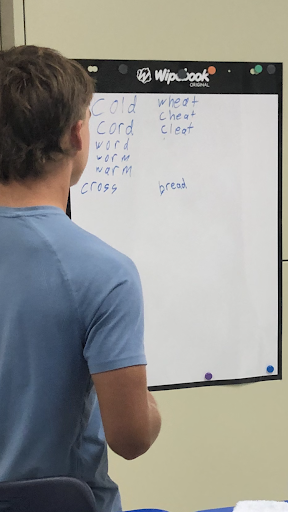As a high school English teacher, my quest for effective teaching strategies led me to the intriguing realm of Building Thinking Classrooms, a transformative approach outlined by Peter Liljedahl, and the Building Thinking Classrooms Conference in the summer of 2023. Enthused by the promise of fostering deep thinking in my students, I eagerly embraced the basic frameworks proposed in Liljedahl’s book. The results were promising, yet as I ventured deeper, I found myself navigating the peaks and valleys of implementation, struggling to move beyond the introductory stages.
The Journey Begins
The initial implementation of Building Thinking Classrooms was an eye-opener. My classroom underwent a profound transformation as students engaged in collaborative problem-solving, utilizing vertical non-permanent surfaces and visibly random groups. The dynamic discussions and heightened student engagement were unmistakable signs of success. I witnessed a clear shift from passive learners to active participants, and I knew I was on to something.

However, as any teacher knows, sustaining momentum and progressing to the next phase is often easier said than done. After successfully integrating vertical non-permanent surfaces and visibly random groups, I found myself unsure of how to elevate my teaching practice further. It was clear that the journey towards a truly thinking classroom required more than just the basics, and I was stalled on how to move forward. I am the only teacher in my building attempting these changes and the weight of the school year was bearing down on me. I encountered moments of uncertainty. Was I doing enough to encourage a growth mindset in my students? How could I refine my questioning techniques to prompt deeper thinking? These questions lingered, pushing me to reflect on my teaching methods and seek avenues for improvement. It was the mental load of overhauling my lesson planning that was getting in the way–not to mention countless days away for sick kids and planned professional development days out of the classroom. Recognizing the need for further growth, I sought guidance from online social media sites that have garnered large followings of the BTC model.
Celebrating Small Wins
Amidst the uncertainties, I reminded myself to celebrate the small wins. The incremental improvements in student collaboration, critical thinking skills, and problem-solving abilities were testament to the efficacy of the Building Thinking Classrooms model. My students were gradually becoming more resilient learners, unafraid to tackle challenging tasks head-on. Students were continually requesting to use the vertical nonpermanent surfaces or wondering when we would be doing something in groups again. To see some of my initial success, please visit my previous blog post, Early Steps in a Transformative Journey Towards a Thinking Classroom.
Moving Forward to Next Semester with Purpose
Through reflecting on my journey with BTC, I have identified the following areas to help me move forward to a successful spring semester using the BTC model.
Self-Reflection and Continued Analysis
I plan to continually reflect on how the BTC frameworks are working in my classes and analyze their role in student learning. In the opening weeks of school, I journaled and reflected on the day’s lessons to help me track BTC success. I hope to get back to this practice in January.
Engage and Collaborate
I plan to actively engage in the online communities to help create a sense of place for myself as I adopt this framework on my own in my building. These communities can also help in the sharing of experiences, ideas, and help troubleshoot challenges. If possible, I will look to attend sessions led by experienced educators who can provide practical insights and share successful strategies for advanced implementation.
Implement Advanced Questioning Techniques
Focusing on crafting questions that prompt deeper thinking, encourage critical analysis, and challenge students to articulate their thought processes more explicitly will be a critical point of focus. By implementing tiered strategies, I hope to alleviate the daily struggles of formulating BTC thinking tasks.
Move Beyond the First Toolkit
When I was implementing the first 3 strategies in the first toolkit, I found great success. I began to practice moments of consolidation and considering the flow of the class. I want to spend time evaluating homework and notes and their role in my classroom.
Create a Feedback Loop
I want to establish a feedback loop with students to gather their perspectives on the effectiveness of Building Thinking Classrooms strategies. Encouraging open communication about what resonates with them and what aspects may need adjustment for a more enriching experience is a way I hope to adapt my BTC experience. I had informal responses, both positive and negative, so I know that I can leverage these through a feedback loop.
The more I learned over the course of the semester, the clearer it became that Building Thinking Classrooms was not a one-size-fits-all approach but rather a dynamic framework that could be tailored to meet the unique needs of my classroom. By implementing these strategies, I can not only build upon the foundation laid in the previous semester but also enhance the effectiveness of Building Thinking Classrooms in fostering a culture of critical thinking, collaboration, and continuous learning.
Conclusion
The journey of implementing Building Thinking Classrooms has been a rollercoaster of challenges and triumphs and the journey to move beyond the basic frameworks has been an experience. While uncertainties and struggles are inevitable, the commitment to continuous learning and the willingness to adapt are essential for growth. As I continue to navigate the peaks and valleys of Building Thinking Classrooms, I am reminded that the pursuit of excellence in teaching is an ongoing adventure—one that promises rewards far beyond the confines of the classroom. I look forward to seeing how these rewards materialize in the spring.
Resources
Please login or register to claim PGPs.
Alternatively, you may use the PGP Request Form if you prefer to not register an account.



